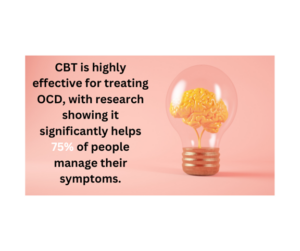If you’re struggling with OCD, you’re not alone, and effective treatments are available. At Archway Behavioral Health, we offer evidence-based therapies such as cognitive behavioral therapy (CBT), dialectical behavior therapy (DBT), and eye movement desensitization and reprocessing (EMDR) to help you manage OCD symptoms. Our comprehensive approach includes individual and group therapy sessions, as well as specialized trauma and depression treatments. For those requiring more intensive care, our partial hospitalization programs (PHP) and intensive outpatient programs (IOP) provide structured support to help you reclaim control over your life. Break free from OCD and reach out to us at (888) 510-3202.
What is OCD?
A Disabling Mental Disorder
Obsessive-compulsive disorder (OCD) is a debilitating psychological condition characterized by persistent, intrusive thoughts (obsessions) and repetitive behaviors or mental acts (compulsions) that significantly disrupt daily functioning.
Brain Abnormalities Implicated
While the exact causes remain unclear, research suggests abnormalities in certain brain regions like the orbitofrontal cortex, anterior cingulate cortex, and basal ganglia may contribute to the development of OCD.
Effective Treatments Available
Though not curable, OCD is highly treatable through a combination of psychotherapy and medication. Cognitive-behavioral therapy (CBT), dialectical behavior therapy (DBT), and acceptance and commitment therapy (ACT) are proven therapeutic approaches. Intensive outpatient programs and partial hospitalization can provide comprehensive care for severe cases.
Major Symptoms of OCD
Intrusive Thoughts
People with OCD often experience persistent, intrusive thoughts or urges that cause significant distress. These obsessive thoughts can be disturbing, illogical, or even taboo. Cognitive behavioral therapy (CBT) helps individuals explore and change these unhelpful thought patterns through goal-setting and exercises.
Compulsive Behaviors
To alleviate anxiety caused by intrusive thoughts, individuals with OCD engage in repetitive behaviors or rituals known as compulsions. These compulsions may involve excessive cleaning, checking, counting, or arranging objects. Dialectical behavior therapy (DBT) teaches mindfulness, distress tolerance, and emotional regulation skills to manage these compulsive behaviors effectively.
Anxiety and Distress
The cycle of obsessions and compulsions often leads to intense anxiety, depression, fear, and distress in those with OCD. This can significantly impair daily functioning and quality of life. EMDR (Eye movement desensitization and reprocessing) is a therapeutic approach that helps the brain reprocess traumatic memories, reducing the negative impact of anxiety and distress associated with OCD.
How CBT Can Help Treat OCD
Challenging Irrational Thoughts & Beliefs
Cognitive Behavioral Therapy (CBT) is highly effective for treating OCD, with research showing it significantly helps 75% of people manage their symptoms. A key aspect is challenging the irrational thoughts, beliefs, and meanings patients attach to their intrusive thoughts and urges. CBT helps reframe distorted thinking patterns that reinforce OCD behaviors.
Exposure and Response Prevention
A central component of CBT for OCD is Exposure and Response Prevention (ERP). This involves gradually exposing the patient to anxiety-provoking situations related to their obsessions while resisting compulsive rituals or avoidance. Through repeated practice, they learn that their feared consequences do not actually occur, breaking the OCD cycle.
Facilitating Acceptance & Adherence
Newer approaches like the treatment protocol studied here aim to improve ERP adherence by combining it with cognitive strategies that help patients accept uncertainty and facilitate exposure to feared stimuli. This can significantly reduce treatment refusal and dropout rates compared to standard ERP.
Empowering Long-Term Management
Overall, CBT empowers OCD patients to become their own therapists, equipping them with tools to challenge unhelpful thoughts, face fears through exposure, and develop healthier coping strategies for lasting symptom relief and prevention of relapse.
What Does an OCD Episode Look Like?
Intense Obsessions and Compulsions
An OCD episode involves a significant escalation of obsessive, intrusive thoughts and compulsive behaviors that disrupt daily life. During these episodes, individuals feel overwhelmed by persistent, unwanted thoughts or images causing severe distress and anxiety. They experience an intense urge to perform repetitive rituals or actions in an attempt to alleviate this distress.
Difficulty Functioning
According to the National Institute of Mental Health, OCD affects around 2.3% of adults in the United States each year. OCD episodes can make it extremely difficult to concentrate on tasks or activities due to the preoccupation with obsessive thoughts. People may avoid situations that could trigger these thoughts, significantly impacting their ability to function in daily life. The compulsive behaviors and rituals intensify, causing further disruption.
Distinguishing OCD Episodes
While OCD involves ongoing obsessions and compulsions, episodes are characterized by a marked increase in symptom severity and frequency. The disruption to daily functioning and the overwhelming nature of the obsessions and compulsions distinguish an OCD episode from general OCD symptoms.
Partial Hospitalization Programs (PHP) for OCD
Intensive OCD Treatment
For those with severe, treatment-resistant OCD, intensive inpatient or partial hospitalization programs (PHPs) can provide a higher level of care. These programs deliver immersive, therapist-assisted cognitive behavioral therapy (CBT) with exposure and response prevention (ERP) on a daily basis, often for 12 weeks or longer.
Proven Effectiveness
Studies show PHPs can significantly reduce OCD symptoms, with response rates ranging from 43% to 79% and remission rates from 26% to 58%. At Rogers Behavioral Health, 1,050 adults in their OCD PHP saw moderate OCD symptoms decrease to mild levels by discharge. Adolescents also showed marked improvement.
Tailored Approach
While intensive, PHPs validate patients’ struggles and provide needed support. Treatment is tailored, as factors like shorter illness duration, better insight, and less contamination/washing symptoms predict better response. Programs may need to enhance outcomes for minoritized youth and those with public insurance.
Intensive Outpatient Programs (IOPs) for OCD
Rapid Symptom Relief
IOPs provide an intensive level of care for individuals with OCD who do not respond well to traditional weekly therapy or have severe symptoms causing significant impairment. These programs offer 8-15 hours of treatment per week over 1-8 weeks, delivered through individual, group, or combined sessions. IOPs can facilitate more rapid symptom reduction for those who prefer an accelerated approach or have plateaued in regular outpatient therapy.
Evidence-Based Approaches
Effective IOPs integrate evidence-based treatments like Exposure and Response Prevention (ERP) with other modalities. One study found that combining ERP with Acceptance and Commitment Therapy (ACT) in an intensive outpatient setting led to a 58% decrease in OCD symptom severity on average, with participants ending treatment in the mild range. This preliminary research supports the potential benefits of an intensive, multi-modal approach.
FAQ: How to Tell if Someone Has OCD
Identifying Obsessions
Obsessions are persistent, intrusive thoughts that cause significant distress. Common obsessions in OCD include fears of contamination, violent impulses, and a need for order or symmetry. These unwanted thoughts can be disturbing and upsetting.
Recognizing Compulsions
Compulsions refer to repetitive behaviors or mental acts driven by obsessions. Examples include excessive hand-washing, checking, counting, or arranging things. People with OCD perform compulsions to temporarily relieve anxiety caused by obsessions.
Interference with Daily Life
A key sign of OCD is when obsessions and compulsions consume over an hour per day and significantly disrupt work, social activities, or relationships. OCD symptoms are beyond normal perfectionism and cannot be easily controlled.
Conclusion
In conclusion, OCD can be a debilitating condition, but effective treatments are available. Through evidence-based therapies like CBT, DBT, and EMDR offered at Archway Behavioral Health, you can find relief from intrusive thoughts and compulsive behaviors. With a success rate of up to 70% for CBT in treating OCD, there is hope for recovery. Whether you choose individual therapy, group sessions, or more intensive options like PHP or IOP programs, taking that first step toward treatment is crucial. Remember, you’re not alone in this journey. With the right support and therapeutic approach, you can regain control of your life and experience significant improvements in your OCD symptoms. Break free from OCD and reach out to us at (888) 510-3202.



